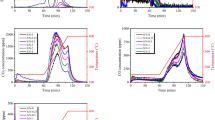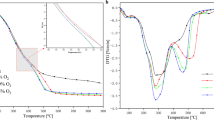Abstract
To reduce chemical carbon consumption in activated coke technology used for flue gas purification, the carbon consumption mechanism of commercial activated coke in the presence of water vapor was studied. A fixed-bed reactor and a Fourier transform infrared (FTIR) spectrometer were combined to study the amount of carbon consumption. Temperature-programmed desorption (TPD) coupled with in situ diffuse reflectance infrared Fourier transform (in situ DRIFT) spectra were used to investigate functional group changes of activated coke. The sources and factors influencing carbon consumption in various adsorption atmospheres and in the N2 regeneration atmosphere were compared. Carbon consumption during the adsorption and regeneration process was mainly due to the release of C–O and C=C groups. The addition of H2O increased the formation of carbonates and carboxylic acids during the adsorption process, which decomposed during the regeneration process, thereby increasing carbon consumption. Carbon consumption was reduced during regeneration in an H2O-SO2 adsorption atmosphere, mainly because of the formation of C–S bonds, which reduced the formation of CO2. The C–N bonds generated in an H2O-NO adsorption atmosphere were decomposed during the regeneration process, thereby increasing carbon consumption. In a complex atmosphere of SO2, NO, NH3, and H2O, SO2 was absorbed by NH3, and the amount of carbon consumption was consistent with that in the NO atmosphere during the regeneration process. The total carbon consumption in various adsorption atmospheres ranged from 85.4 to 125.2 μmol/g. Compared with an anhydrous atmosphere, chemical carbon consumption increased by 6.5–14.3% in the presence of H2O. Chemical carbon consumption was reduced by decreasing the H2O concentrations, which provides a reference concept for reducing the operating cost of the activated coke process in industry.














Similar content being viewed by others
References
Bagreev A, Rahman H, Bandosz T (2000) Study of H2S adsorption and water regeneration of spent coconut-based activated carbon. Environ Sci Technol 34:4587–4592. https://doi.org/10.1021/es001150c
Beker U, Ganbold B, Dertli H et al (2010) Adsorption of phenol by activated carbon: influence of activation methods and solution pH. Energy Convers Manag 51(2):235–240. https://doi.org/10.1016/j.enconman.2009.08.035
Cui X, Yi H, Tang X, Zhao S, Yang K, Yan B, Li C, Yang X, Feng T, Ma Y (2018) Study on the properties of adsorption of SO2—thermal regeneration cycle of activated coke modified by oxidization. J Chem Technol Biotechnol 93:720–729. https://doi.org/10.1002/jctb.5421
Ding S, Li Y, Zhu T, Guo Y (2015) Regeneration performance and carbon consumption of semi-coke and activated coke for SO2 and NO removal. J Environ Sci 34:37–43. https://doi.org/10.1016/j.jes.2015.02.004
Fan Q, Sun J, Chu L, Cui L, Quan G, Yan J, Hussain Q, Iqbal M (2018) Effects of chemical oxidation on surface oxygen-containing functional groups and adsorption behavior of biochar. Chemosphere 207:33–40. https://doi.org/10.1016/j.chemosphere.2018.05.044
Figueiredo J, Pereira M (2010) The role of surface chemistry in catalysis with carbons. Catal Today 150:2–7. https://doi.org/10.1016/j.cattod.2009.04.010
Gao X, Liu S, Zhang Y, Luo Z, Cen K (2011) Physicochemical properties of metal-doped activated carbons and relationship with their performance in the removal of SO2 and NO. J Hazard Mater 188:58–66. https://doi.org/10.1016/j.jhazmat.2011.01.065
Guo Y, Liu Z, Liu Q, Huang Z (2008) Regeneration of a vanadium pentoxide supported activated coke catalyst-sorbent used in simultaneous sulfur dioxide and nitric oxide removal from gas: effect of ammonia. Catal Today 131:322–329. https://doi.org/10.1016/j.cattod.2007.10.032
Guo Y, Li Y, Zhu T, Ye M (2013) Effects of concentration and adsorption product on the adsorption of SO2 and NO on activated carbon. Energy Fuel 27:360–366. https://doi.org/10.1021/ef3016975
Guo Y, Li Y, Zhu T, Ye M (2015) Investigation of SO2 and NO adsorption species on activated carbon and the mechanism of NO promotion effect on SO2. Fuel 143:536–542. https://doi.org/10.1016/j.fuel.2014.11.084
Im Y, Lee S, Kim T, Park J, Lee J, Lee K (2017) Utilization of carboxylic functional groups generated during purification of carbon nanotube fiber for its strength improvement. Appl Surf Sci 392:342–349. https://doi.org/10.1016/j.apsusc.2016.09.060
Jastrząb K (2012) Changes of activated coke properties in cyclic adsorption treatment of flue gases. Fuel Process Technol 104:371–377. https://doi.org/10.1016/j.fuproc.2012.06.011
Klose W, Rincón S (2007) Adsorption and reaction of NO on activated carbon in the presence of oxygen and water vapour. Fuel 86:203–209. https://doi.org/10.1016/j.fuel.2006.06.017
Li Y, Guo Y, Xiong J, Zhu T, Hao J (2016) The roles of sulfur-containing species in the selective catalytic reduction of NO with NH3 over activated carbon. Ind Eng Chem Res 55:12341–12349. https://doi.org/10.1021/acs.iecr.6b03255
Lin Y, Li Y, Xu Z, Xiong J, Zhu T (2018) Transformation of functional groups in the reduction of NO with NH3 over nitrogen-enriched activated carbons. Fuel 223:312–323. https://doi.org/10.1016/j.fuel.2018.01.092
Liu Y, Qu Y, Guo J, Wang X, Chu Y, Yin H, Li J (2015) Thermal regeneration of manganese supported on activated carbons treated by HNO3 for desulfurization. Energy Fuel 29:1931–1940. https://doi.org/10.1021/ef502655k
Liu Y, Ning P, Li K, Li T, Hao J, Song X, Zhang G, Wang C (2017) Simultaneous removal of NOx and SO2 by low-temperature selective catalytic reduction over modified activated carbon catalysts. Russ J Phys Chem A 91:490–499. https://doi.org/10.1134/S003602441703030X
Ma J, Huang Z, Liu Z, Guo S (2005) Effect of regeneration method on activity for simultaneous removal of SO2 and NO over V2O5/AC catalyst-sorbent. Chin J Catal 26:463–469. https://doi.org/10.3321/j.issn:0253-9837.2005.06.009
Qu Z, Sun F, Liu X, Gao J, Qie Z, Zhao G (2018) The effect of nitrogen-containing functional groups on SO2 adsorption on carbon surface: enhanced physical adsorption interactions. Surf Sci 677:78–82. https://doi.org/10.1016/j.susc.2018.05.019
Sahin O, Saka C (2013) Preparation and characterization of activated carbon from acorn shell by physical activation with H2O-CO2 in two-step pretreatment. Bioresour Technol 136:163–168. https://doi.org/10.1016/j.biortech.2013.02.074
Shafeeyan M, Daud W, Houshmand A, Shamiri A (2010) A review on surface modification of activated carbon for carbon dioxide adsorption. J Anal Appl Pyrolysis 89:143–151. https://doi.org/10.1016/j.jaap.2010.07.006
Sun F, Gao J, Zhu Y, Qin Y (2011) Mechanism of SO2 adsorption and desorption on commercial activated coke. Korean J Chem Eng 28:2218–2225. https://doi.org/10.1007/s11814-011-0078-5
Sun F, Gao J, Liu X, Tang X, Wu S (2015) A systematic investigation of SO2 removal dynamics by coal-based activated cokes: the synergic enhancement effect of hierarchical pore configuration and gas components. Appl Surf Sci 357:1895–1901. https://doi.org/10.1016/j.apsusc.2015.09.118
Sun X, Ruan H, Song X, Sun L, Li K, Ning P, Wang C (2018) Research into the reaction process and the effect of reaction conditions on the simultaneous removal of H2S, COS and CS2 at low temperature. RSC Adv 8:6996–7004. https://doi.org/10.1039/C7RA12086A
Wang J, Yan Z, Liu L, Chen Y, Zhang Z, Wang X (2014) In situ DRIFTS investigation on the SCR of NO with NH3 over V2O5 catalyst supported by activated semi-coke. Appl Surf Sci 313:660–669. https://doi.org/10.1016/j.apsusc.2014.06.043
Wang P, Jiang X, Zhang C, Zhou Q, Li J, Jiang W (2017) Desulfurization and regeneration performance of titanium-ore-modified activated coke. Energy Fuel 31:5266–5274. https://doi.org/10.1021/acs.energyfuels.6b03153
Wang J, Lu P, Su W, Xing Y, Li R, Li Y, Zhu T, Yue H, Cui Y (2019) Study on the denitrification performance of FexLayOz/activated coke for NH3-SCR and the effect of CO escaped from activated coke at mid-high temperature on catalytic activity. Environ Sci Pollut Res 26:20248–20263. https://doi.org/10.1007/s11356-019-05090-5
Wu C, Song M, Jin B, Wu Y, Zhong Z, Huang Y (2013) Adsorption of sulfur dioxide using nickel oxide/carbon adsorbents produced by one-step pyrolysis method. J Anal Appl Pyrolysis 99:137–142. https://doi.org/10.1016/j.jaap.2012.10.011
Xie R, Jin Y, Chen Y, Jiang W (2017) The importance of surface functional groups in the adsorption of copper onto walnut shell derived activated carbon. Water Sci Technol 76:3022–3034. https://doi.org/10.2166/wst.2017.471
Yang L, Jiang X, Yang Z, Jiang W (2015) Effect of MnSO4 on the removal of SO2 by manganese-modified activated coke. Ind Eng Chem Res 54:1689–1696. https://doi.org/10.1021/ie503729a
Yang L, Jiang X, Jiang W, Wang P, Jin Y (2017) Cyclic Regeneration of pyrolusite-modified activated coke by blending method for flue gas desulfurization. Energy Fuel 31:4556–4564. https://doi.org/10.1021/acs.energyfuels.7b00125
Yin H, Lu W, Sun G, Sun G, Hong B (2015) Technology of coke oven flue gas purification and discussion on its process. Fuel Chem Process 46:1–4. https://doi.org/10.16044/j.cnki.rlyhg.2015.02.001
Zhou L, Yu Q, Cui Y, Xie F, Li W, Li Y, Chen M (2017) Adsorption properties of activated carbon from reed with a high adsorption capacity. Ecol Eng 102:443–450. https://doi.org/10.1016/j.ecoleng.2017.02.036
Acknowledgments
This work was supported by the National Key R&D Program of China (No. 2017YFC0210203), the National Natural Science Foundation of China (No. U1810209), and the Industry-School-Research Institution Program of HBIS Group Tangsteel Company.
Author information
Authors and Affiliations
Corresponding authors
Additional information
Responsible editor: Bingcai Pan
Publisher’s note
Springer Nature remains neutral with regard to jurisdictional claims in published maps and institutional affiliations.
Electronic supplementary material
ESM 1
(DOCX 632 kb)
Rights and permissions
About this article
Cite this article
Guo, J., Li, Y., Wang, B. et al. Carbon consumption mechanism of activated coke in the presence of water vapor. Environ Sci Pollut Res 27, 1558–1568 (2020). https://doi.org/10.1007/s11356-019-06747-x
Received:
Accepted:
Published:
Issue Date:
DOI: https://doi.org/10.1007/s11356-019-06747-x




